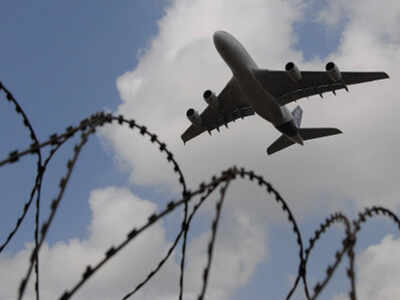
Chennai is strategically positioned. Lying on the intercontinental air route that connects Europe with the Middle East and Australia, it has all the makings of an international hub, but a schedule of flights shows that hardly a quarter of its potential is used when it comes to destinations in the west.
As of now, it has good connectivity to the Middle East and South-East Asia, but the airport is unable to attract airlines to fly on Chennai-Australia and Chennai-Europe sectors, pushing away most of the traffic to the plush Changi airport in Singapore, despite it being a deviation. Around 40% of the passengers on a flight to Changi airport fly beyond Singapore to China, Australia, New Zealand and destinations in the US.
But with people avoiding flying via Singapore to Australia, the US and Europe because of the Covid-19 scare, this traffic is moving to Colombo, Bengaluru and Mumbai for transit. Another lost opportunity for Chennai airport, which has failed to market the facility and make the most of its geographical location, losing out on a chance to draw transit traffic that is moving away from Singapore and now Dubai because of the novel coronavirus scare (Covid-19).

The plan of making Chennai a hotspot on the global air traffic map was proposed in 2013, when the Airports Authority of India (AAI) suggested developing the airport as a major hub on the lines of Dubai and Singapore. The then AAI chairman V P Agarwal mooted the idea when the airport opened its new terminals in 2013. The authority was looking at developing the airport into a hub and allow airlines to park more planes and start more flights to domestic and international destinations because the location was suitable.
The plan is still on, almost six years later, but only on paper. In the meantime, Bengaluru, located just half an hour away, has started to tap into the potential. One the fastest growing airport in the country, the ‘Silicon Valley of India’ is taking over through aggressive marketing. It has managed to encourage airlines to start more flights to international destinations and will soon have direct flights to Seattle, Munich and Tokyo. In comparison, Chennai is going to have new flights only to Adis Ababa later in the year. There are already direct flights from Bengaluru to European hubs such as Paris, Frankfurt and Amsterdam, while Chennai has flights only to London and Frankfurt. Another one to Paris is set to resume in June.
An airport official said shortfalls in design of the airport terminals, slow pace of work to build taxiways, inability to extend the second runway, and the inability to open the ground floor arrival hall of the international terminal are among the reasons that have constricted the flight handling capacity of Chennai airport. "Bengaluru being a private airport does not face the limitations that government-run airports have in attracting airlines," he said. But Though the AAI took part at a routes’ conference and also markets its airports — Kolkata and Chennai — at international forums, foreign airlines are not happy with the turnaround time offered by the airports. Long and short haul international flights need to return within an hour of arrival and delays in ground handling and congestion at airside at night cause delays.
While Chennai plays catch up, scaling up operations with the future in mind is giving Bengaluru an edge. Air Passengers Association of India (APAI) national president D Sudhakara Reddy said, "Bengaluru airport is taking a proactive and positive approach in marketing the facility with airlines. They also take feedback from experts to improve passenger experience. This is evident from the way the airport has grown in the past few years."
"We estimate that passenger volumes at Bengaluru airport will be between 55 million to 65 million per annum in the next five years. To support this growth, BIAL is investing Rs13,000 crore in infrastructure expansion, including the South Runway, which is operational, and the first phase of Terminal 2," Hari Marar, managing director and CEO of Bangalore International Airport Limited, said in a statement. The Bengaluru airport now gets around 30 million passengers per year. Meanwhile, AAI is looking to increase passenger capacity to 30 million per year in Chennai after modernising the airport, which is likely to take two years.
If Chennai was able to expand, it would have had international flights to Australia, the Middle East and Europe — all on the same intercontinental air route that crisscross above the city, on which is also Dubai, but will it, is the question.
As of now, it has good connectivity to the Middle East and South-East Asia, but the airport is unable to attract airlines to fly on Chennai-Australia and Chennai-Europe sectors, pushing away most of the traffic to the plush Changi airport in Singapore, despite it being a deviation. Around 40% of the passengers on a flight to Changi airport fly beyond Singapore to China, Australia, New Zealand and destinations in the US.
But with people avoiding flying via Singapore to Australia, the US and Europe because of the Covid-19 scare, this traffic is moving to Colombo, Bengaluru and Mumbai for transit. Another lost opportunity for Chennai airport, which has failed to market the facility and make the most of its geographical location, losing out on a chance to draw transit traffic that is moving away from Singapore and now Dubai because of the novel coronavirus scare (Covid-19).

The plan of making Chennai a hotspot on the global air traffic map was proposed in 2013, when the Airports Authority of India (AAI) suggested developing the airport as a major hub on the lines of Dubai and Singapore. The then AAI chairman V P Agarwal mooted the idea when the airport opened its new terminals in 2013. The authority was looking at developing the airport into a hub and allow airlines to park more planes and start more flights to domestic and international destinations because the location was suitable.
The plan is still on, almost six years later, but only on paper. In the meantime, Bengaluru, located just half an hour away, has started to tap into the potential. One the fastest growing airport in the country, the ‘Silicon Valley of India’ is taking over through aggressive marketing. It has managed to encourage airlines to start more flights to international destinations and will soon have direct flights to Seattle, Munich and Tokyo. In comparison, Chennai is going to have new flights only to Adis Ababa later in the year. There are already direct flights from Bengaluru to European hubs such as Paris, Frankfurt and Amsterdam, while Chennai has flights only to London and Frankfurt. Another one to Paris is set to resume in June.
An airport official said shortfalls in design of the airport terminals, slow pace of work to build taxiways, inability to extend the second runway, and the inability to open the ground floor arrival hall of the international terminal are among the reasons that have constricted the flight handling capacity of Chennai airport. "Bengaluru being a private airport does not face the limitations that government-run airports have in attracting airlines," he said. But Though the AAI took part at a routes’ conference and also markets its airports — Kolkata and Chennai — at international forums, foreign airlines are not happy with the turnaround time offered by the airports. Long and short haul international flights need to return within an hour of arrival and delays in ground handling and congestion at airside at night cause delays.
While Chennai plays catch up, scaling up operations with the future in mind is giving Bengaluru an edge. Air Passengers Association of India (APAI) national president D Sudhakara Reddy said, "Bengaluru airport is taking a proactive and positive approach in marketing the facility with airlines. They also take feedback from experts to improve passenger experience. This is evident from the way the airport has grown in the past few years."
"We estimate that passenger volumes at Bengaluru airport will be between 55 million to 65 million per annum in the next five years. To support this growth, BIAL is investing Rs13,000 crore in infrastructure expansion, including the South Runway, which is operational, and the first phase of Terminal 2," Hari Marar, managing director and CEO of Bangalore International Airport Limited, said in a statement. The Bengaluru airport now gets around 30 million passengers per year. Meanwhile, AAI is looking to increase passenger capacity to 30 million per year in Chennai after modernising the airport, which is likely to take two years.
If Chennai was able to expand, it would have had international flights to Australia, the Middle East and Europe — all on the same intercontinental air route that crisscross above the city, on which is also Dubai, but will it, is the question.
Trending Topics
LATEST VIDEOS
City
 Dowry harassment: Flipkart co-founder Sachin Bansal's wife files case against him
Dowry harassment: Flipkart co-founder Sachin Bansal's wife files case against him  Covid-19: 26-year-old Paytm employee tests positive for novel coronavirus
Covid-19: 26-year-old Paytm employee tests positive for novel coronavirus  UP cops take seized SUV for ride; owner locks them inside for three hours
UP cops take seized SUV for ride; owner locks them inside for three hours  '15 crore Muslims' remark: AIMIM leader Waris Pathan to appear before Kalaburagi police on March 8
'15 crore Muslims' remark: AIMIM leader Waris Pathan to appear before Kalaburagi police on March 8
More from TOI
Navbharat Times
Featured Today in Travel
Get the app





